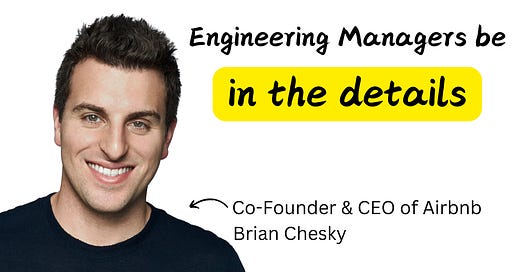Great Leaders Are in the Details
"Founder Mode" and why being in the details is key to high-performing engineering teams.
“Hire Great People and Step Back”
As an engineering manager, I have heard in the past "hire great people, set clear goals, and get out of the way". It sounds empowering, almost liberating: trust your team to handle the execution while you focus on strategy. But as Brian Chesky, Airbnb’s CEO, learned the hard way, this approach doesn’t work.
The reality? Many leaders who "step back" from the details inadvertently abdicate their most critical responsibilities. They risk becoming disconnected from their teams and allowing issues to fester until they reach crisis proportions. As Paul Graham noted, this approach for leaders aiming to drive meaningful impact, whether they’re startup founders or engineering managers, is a recipe for mediocrity.
Why the Details Matter
Good leadership is about presence, not absence. "Founder mode," as Chesky described it, hinges on being in the details, not to micromanage but to understand and partner deeply with your team. This is particularly critical in engineering, where complexities compound and decisions made at the lowest levels can ripple into major product challenges.
Here’s why details matter in engineering leadership:
Clarity in Execution: Engineers thrive on clarity. When leaders are in the details, they can help resolve ambiguity, align priorities, and ensure everyone is building the right thing.
Avoiding Misalignment: It’s easy for engineering teams to go off course when leaders aren’t involved in the specifics. Misaligned priorities between product, engineering, and business can derail sprints and waste months of effort.
Fostering a Culture of Excellence: Attention to detail sets the standard for the team. When leaders scrutinize the quality of design documents or challenge suboptimal decisions, it raises the bar for everyone.
The Difference Between Micromanaging and Engaging
Let’s address the elephant in the room: doesn’t being in the details make you a micromanager?
Not necessarily. The distinction lies in how you approach the details. Micromanagers dictate; great leaders collaborate. Steve Jobs didn’t micromanage Jony Ive’s design studio at Apple, he partnered with him, engaging deeply in decisions that shaped Apple’s legendary products.
As Chesky describes, the goal is to create a shared consciousness between you and your team, where leadership feels more like a partnership than a hierarchy. This requires:
Curiosity, not control: Ask questions and seek to understand the rationale behind decisions.
Empowerment, not overreach: Provide guidance and remove blockers without taking over execution.
Consistency, not interference: Regularly engage with your team so your involvement feels supportive, not reactive.
How to Get in the Details
Being in the details doesn’t mean obsessing over every line of code or attending every meeting. Instead, it’s about knowing where to focus your attention and how to scale your involvement as your team grows.
1. Start in the Trenches
When you’re building a new team or tackling a major project, dive deep. This helps you establish context and build rapport with your engineers.
Example: Airbnb’s Chesky reviewed product press releases himself, sometimes up to 70 revisions, until his team internalized the standards he expected. Over time, he scaled back to reviewing only the most critical ones.
2. Choose High-Impact Areas
Not all details are equally important. Focus on decisions that:
Influence long-term architecture or scalability
Directly impact customers or revenue
Represent recurring patterns of inefficiency or misalignment
3. Be Present in Key Meetings
Don’t just rely on reports. Join design reviews, post-mortems, or sprint planning sessions where critical decisions are made. Use these opportunities to ask probing questions and surface risks early.
4. Set Standards Through Feedback
Your engagement should teach, not overwhelm. Use feedback to reinforce what great looks like, whether that’s clean code, a well-structured ADR, or a thoughtful incident response.
5. Delegate, Then Verify
Once your team internalizes your expectations, step back incrementally. Trust, but verify. For example, be present in a subset of team decisions instead of all of them, or ask team leads to escalate only major decisions.
Overcoming the Fear of "Being the Bottleneck"
A common objection to being in the details is the fear of slowing down the team. But as Chesky’s experience shows, the real bottleneck is often misalignment or unclear direction, not leadership involvement.
When you’re present in the details, you can:
Spot issues early: It’s easier to fix a misaligned architecture or pivot a project direction in its early stages than after months of work.
Enable faster decisions: Your familiarity with the specifics means you can resolve questions or unblock teams faster.
Ensure quality from the start: Setting a high bar upfront reduces the need for rework later.
Being detail-oriented doesn’t mean hovering over your team. It means creating an environment where everyone moves in sync, and where your involvement amplifies, rather than stifles, their efforts.
Building the Next Generation of Engineering Leaders
Engineering managers often feel the pressure to scale themselves out of the day-to-day as their teams grow. But as the concept of "founder mode" reveals, great leaders don’t abandon the details, they adapt their involvement to the company’s needs.
By being present, curious, and intentional, you can lead your team to create great products, not because you’re doing their work for them, but because you’re setting the standard for excellence.
Being in the details isn’t just about making better products or solving technical challenges. It’s about building trust. Your team will know that you’re invested in their success and that they can rely on you to guide them when it matters most.
In the words of Chesky: "Great leadership is presence, not absence." For engineering managers, that means putting down the myth of managerial detachment and embracing the details, because that’s where greatness happens.
Useful links
📂 Get my 50 Engineering Manager Notion Templates to streamline hiring, onboarding, team management, and more!
🎉 CodeCrafters helps you become a better Software Engineer using my favourite method! Build your own Redis, Git, Kafka and more from scratch. Use my partner link if you want to get 40% off.
🚀 Check out my Leadership Accelerator program. Let’s set up a free intro call and chat about how I can help you in your leadership journey.
👋 Let’s connect on LinkedIn to exchange ideas, share insights, and grow together!
If you wish to make a request on a particular topic you would like to read, you can send me an email at stephane@em-tools.io.
TL;DR
Being in the details isn’t micromanagement, it’s creating clarity, alignment, and trust.
Focus on high-impact areas: customer-critical features, long-term architecture, or recurring inefficiencies.
Start deep, scale gradually: Teach your team what great looks like, then step back incrementally.
Lead through partnership: Collaborate with your team, challenge their thinking, and set the standard for excellence.
Presence over absence: Great leaders inspire confidence by being engaged in what matters most.






I have been witness to the disconnection from teams that can occur, when leaders abdicate their leadership. Tensions can festers. Collegues can become resentful. As with anything, I say do it in moderation and keep in balance. Empowering your team is great - but do not do it to the point you are absent.